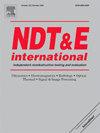中子/ x射线三维断层成像配准与融合方法研究
IF 4.5
2区 材料科学
Q1 MATERIALS SCIENCE, CHARACTERIZATION & TESTING
引用次数: 0
摘要
与二维中子/ x射线计算机断层扫描(CT)图像融合相比,三维(3D)融合可以实现更全面、更准确的数据分析。因此,研究了中子/ x射线三维CT图像的融合方法。为了丰富融合图像的信息,增强融合图像的清晰度,首先提出了一种基于NSCT分解的图像融合方法,将中子和x射线图像分解到不同尺度空间,分别按照取平均值、取最大绝对值和结合双通道单元连接PCNN (Pulse Coupled Neural Network,脉冲耦合神经网络)模型的融合规则对不同尺度空间的图像进行融合。然后,利用被测样品中子和x射线层析成像的结构一致性,提出了一种基于结构相似度(SSIM)指数的双源(中子/ x射线)层析成像配准方法。因此,开发了一种三维层析融合方法,实现了体积图像融合。在3D融合图像中,塑料材料的结构表征主要来自中子层析成像,显示出较高的灰度值,而金属成分信息主要来自x射线层析成像,显示出较低的灰度值。融合后的图像通过融合中子和x射线两种模式的互补信息合成,从而丰富了结构细节,通过跨模式数据融合极大地增强了材料识别能力,未来可应用于航空航天、电能、多相流和复合材料等多个领域的材料识别和检测。本文章由计算机程序翻译,如有差异,请以英文原文为准。
Study on registration and fusion methods for neutron/X-ray three-dimensional tomography images
Compared to two-dimensional neutron/X-ray computed tomography (CT) image fusion, three-dimensional (3D) fusion enables more comprehensive and accurate data analysis. Therefore, fusion method of neutron/X-ray 3D CT images was studied. In order to enrich information and enhance clarity of the fusion image, a NSCT decomposition-based image fusion method was firstly proposed, the neutron and X-ray images were decomposed into different scale spaces, and image fusion in different scale spaces was performed according to the fusion rules of taking average value, taking the maximum absolute value and the fusion rule of combining the dual-channel unit-linking PCNN (Pulse Coupled Neural Network) model, respectively. Then, using structural consistency between neutron and X-ray tomographic images of a tested sample, a structural similarity (SSIM) index-based inter-layer registration method for dual-source (neutron/X-ray) tomographic images was proposed. A 3D tomographic fusion method was thereby developed and volumetric image fusion was achieved. In the 3D fusion images, the structural representations of plastic materials are predominantly derived from neutron tomographic image, exhibiting higher gray values, while metallic component information is primarily sourced from X-ray tomographic image, showing lower gray values. The fused images are synthesized by integrating the complementary information from both neutron and X-ray modalities, leading to enriched structural details that critically enhance material identification capabilities through cross-modal data fusion, which can be applied to the identification and detection of materials in multiple fields such as aerospace, electric energy, multiphase flow and composite materials in the future.
求助全文
通过发布文献求助,成功后即可免费获取论文全文。
去求助
来源期刊

Ndt & E International
工程技术-材料科学:表征与测试
CiteScore
7.20
自引率
9.50%
发文量
121
审稿时长
55 days
期刊介绍:
NDT&E international publishes peer-reviewed results of original research and development in all categories of the fields of nondestructive testing and evaluation including ultrasonics, electromagnetics, radiography, optical and thermal methods. In addition to traditional NDE topics, the emerging technology area of inspection of civil structures and materials is also emphasized. The journal publishes original papers on research and development of new inspection techniques and methods, as well as on novel and innovative applications of established methods. Papers on NDE sensors and their applications both for inspection and process control, as well as papers describing novel NDE systems for structural health monitoring and their performance in industrial settings are also considered. Other regular features include international news, new equipment and a calendar of forthcoming worldwide meetings. This journal is listed in Current Contents.
 求助内容:
求助内容: 应助结果提醒方式:
应助结果提醒方式:


